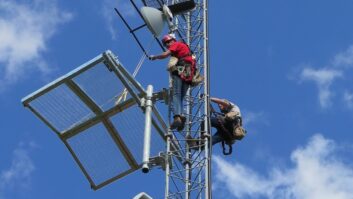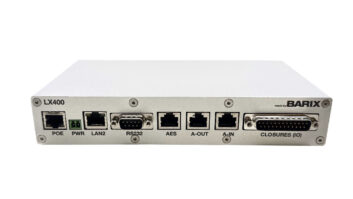Durst Organization Says Its Communications Upgrade Enables Interoperability Between NYPD, FDNY, EMS
(click thumbnail)Avtec VoIP Control Console
(click thumbnail)Typical FDNY and Durst Repeater Rack
(click thumbnail)Interoperability Unit in Portable Housing (battery not shown)
(click thumbnail)Durst Building Communications System One-Line Drawing (right-click to download linked PDF file)
(click thumbnail)Typical TX RX Systems Inc. EMS/NYPD Bi-Directional Amplifier
(click thumbnail)Typical TX RX Systems Inc. Combiner System
(click thumbnail)Harris Microwave System (Tru-Point Radios and NetVX)
(click thumbnail)Fiber Termination (Single Mode and 50-micron Multimode Fiber)
(click thumbnail)Fire Command Console
On May 31, The Durst Organization announced that it has upgraded communications within its portfolio of Manhattan high-rise buildings to facilitate two-way radio communications for first responders, including the Fire Department of New York, Emergency Medical Services, New York Police Department and others.
Over the last two years, we have upgraded communications within the portfolio to make certain the buildings – covering 7.5 million square feet of commercial real estate – are virtually covered, with no “blind” areas anywhere – from the sub-basements to the rooftop, from the freight elevator lobbies to the elevators to all exit stairs.
We are in the final stages of testing with FDNY and EMS throughout the entire portfolio. We also are working with the NYPD to enhance their citywide radio coverage by providing state-of-the-art radio transmitting facilities. In addition, we are working with NYPD to identify and install new and compatible radio technologies to further enhance NYPD’s in-building radio coverage.
The system was designed with input from FDNY and EMS every step of the way. They were involved with extensive testing and retesting in the buildings before their sign-off. During the development process, they added additional features as we proved that the previous features were operational. (Even though EMS is a division of FDNY, the design and testing is different in structure. For this reason, I address them as separate entities.)
Civil service
There were many challenges in making this work, as the FDNY system is different from the EMS/NYPD system, and the parameters and controls were different. FDNY wanted to have its repeaters under its control so the repeaters would not be operating 24/7 and possibly impeding communications if responding to an incident in an adjacent or near-field building.
The FDNY part of the system is completely under the control of FDNY and activates when FDNY takes control of the repeaters via the FDNY key that also controls the elevator recall to the lobby. Otherwise, the system remains in a stand-by mode, powered-up but inactive. The EMS/NYPD system will be active 24/7 and is fed externally through a donor antenna to a BDA (Bi-directional Amplifier) system within the buildings.
The BDAs have been tested with EMS and are operational. The NYPD BDAs have not yet been tested with NYPD so they are not operational at the time of this article.
FDNY requires an APCO 25 feature. (For more information on APCO 25, visit www.apcointl.org.) This feature allows a digital ID to be transmitted using the Push-to-Talk switch. Additionally, FDNY requires a digital “man-down” alarm to be transmitted over the system. An emergency button on the FDNY radio keys this alarm. When pressed, an audible alarm goes throughout the system as well as the digital ID, indicating a firefighter is in trouble. This system consists of Tait Electronics APCO 25 repeaters (www.taitworld.com) installed on a coaxial cable network throughout the Durst facilities.
These frequencies are tactical frequencies, building-specific as compared to FDNY’s citywide frequencies. These frequencies internally cover virtually 100 percent of the Durst facilities. There are two APCO 25 repeaters per channel per building – configured as primary and secondary, installed into combiners and multicouplers – which enable The Durst Organization to run its own radio frequencies as well (using Tait Electronics repeaters) into this cable and antennae infrastructure.
The remote handset system, designed by North American Mobile Systems Inc., patent pending, is installed in the fire-control panels in the lobbies of all buildings in a place specified by FDNY, and the design has been approved by FDNY.
In addition to controlling the repeaters, the fire command location controllers have the ability to override any radio conversation on the system. This feature also was incorporated at the request of FDNY.
Two additional unique features requested by FDNY and supplied by The Durst Organization were the abilities to monitor the systems remotely and use VoIP into the tactical channels. A successful test has been conducted from FDNY HQ to firefighters on scene at 4 Times Square, and they were able to communicate from the Command desk at HQ in Brooklyn to the firefighter anywhere in the building at 4 Times Square, Manhattan. The VoIP system is provided by Avtec Inc. (www.avtecinc.com)
Interoperability
Another impressive feature the system offers is interoperability for First Responders.
NYPD, EMS, FDNY and other agencies can speak with each other directly through this system once accepted by all agencies involved, even though they are not on the same frequencies. In the event of the interoperability feature failure, all radios remain operable within their original service, i.e., FDNY can still communicate with FDNY, EMS with EMS, etc.
In the event of a total breakdown of the system, such as in the case of a building collapse or something as catastrophic, the Durst Organization has provided high-power backup facilities at remote sites under control of FDNY. This new interoperability system is not hard-wired into the communications system, thus eliminating the single point of failure associated with such systems in the past. The interoperability equipment is provided by Lonestar Concepts. (www.lonestar-concepts.com)
NYPD, EMS and FDNY have “citywide” repeater channels that do cover the streets and some perimeter office space very well, but for all intents and purposes are substantially lacking as far as in-building coverage, especially in egress areas such as stairwells, elevators, the building core and sub-basements.
Schematically, the typical Durst in-building system is straightforward and works similar to an IT ring network where the nodes are connected in a closed loop configuration. A break in the cable may result in degraded data speed but the data is still flowing from terminal to terminal.
Similarly in our system, we employ this means of connecting the repeaters and BDAs around the individual buildings. Should there be a cable failure near the primary repeaters or BDAs, the secondary repeaters or BDAs will be able to use the cable up to the break point for continuous communications with the distributed antenna system along the path as well as along its own main cables (see Fig. 1).
The BDAs and combiners are supplied by TX RX Systems Inc. ( www.txrx.com ) The Durst communications system uses Motorola EX600-XLS handheld radios (www.motorola.com)
We hope this project will launch a concerted effort by the private sector to provide enhanced communications for the first responders in all communities nationwide.





















